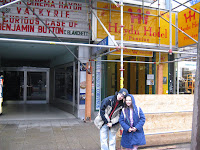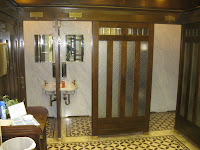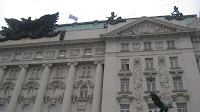
(a picture of the hat I bought - clearly Austria has a sense of humor - the "Austria, no kangaroos" logo was very common)
Well, it was mid-term school break, time to hit the road again!! Last year at this time we did the Germany, Switzerland, Holland loop. This time we decided to hit three major cities in Eastern Europe, Vienna, Prague and Budapest. We flew into Vienna, got a family room and used it as home base for the whole 9 day trip. That was nice, it allowed us to just take overnight bags to Prague and Budapest.
Vienna used Euros (1.25 = 1$) and spoke German, Prague used Crowns (20=1$) and spoke Czech, and Budapest used Forints (200=1$) and spoke Hungarian. So including the UK pounds in my pocket, I was carrying four different types of currency at one time or another. You should have seen the look on the faces when I accidentally would try to spend an inappropriate bill. It was very confusing to figure out the best prices.
The people were incredibly friendly, often approaching us and offering directions. The first day there a very large, scruffy young man approached John and I while we were waiting for the girls to get ready. I was very uncomfortable, fearing the worst. He just came up and said in pretty good English, "Can I help you find something?" When I told him we were just waiting for the rest of the family, he proceeded to point out some of the nearby sights and then just walked away.
One characteristic that fit all three was the buildings had style. Even many of the more mundane buildings had little touches of class that made each of the three cities very beautiful and "old world" feeling. To honor that, I am adding a "miscellaneous pictures" section to the bottom of each of these three posts.
Haydn Hotel
Here's where we stayed. Despite the appearance of the scaffolding outside, it was perfect. It was a block from the 'U-Bahn' (subway), in the middle of the biggest shopping district in Vienna (called Mariahilfer strasse), and reasonably priced. A weird coincidence, as you can see there is an English language movie theater next door. Right next to the theater there was also a small, but incredibly ornate on the inside, church who's bells rang incredibly loudly early Sunday mornings. Notice the statue of Haydn in front.


The House of Music
Vienna (called "Wein" locally, pronounced "veen") is known for music, with the Strauss family, Haydn and Brahms being from there. There was a hands on museum about the major composers.
The coolest exhibit was the one pictured below, at which (using Wii-like technology) you have the opportunity to conduct the Vienna Philharmonic Orchestra. You pick a song off the menu and hold the baton, and conduct. The orchestra follows your lead, as slow or fast as you conduct. But, if you go too slow or too fast for too long, the orchestra puts down their instruments and yells at you in German. Hilarious!


Trinity Column / Plague Monument
Europe was devastated by the plague 400 years ago, and each of these cities have monuments to those who died and to indicate the gratitude of the survivors. One third of Vienna died.
Europe was devastated by the plague 400 years ago, and each of these cities have monuments to those who died and to indicate the gratitude of the survivors. One third of Vienna died.
Ferris Wheel
This is in the Prater, a park donated by the emperor Franz Joseph to the people. It is 100+ years old and over 200 feet tall. Great views from the top. Each of the wooden "cars" are shaped like train cars and will hold about 30.



This is in the Prater, a park donated by the emperor Franz Joseph to the people. It is 100+ years old and over 200 feet tall. Great views from the top. Each of the wooden "cars" are shaped like train cars and will hold about 30.



Charles Church
This is a "votive church", a gift to honor someone. This church is dedicated to a local Bishop (want to guess his name?) that served the people of Vienna during the plague.
The really interesting thing about it is the opportunity to go up to the painted dome while it is being restored. You can see how they distort the pictures in order that they look normal 200 feet below. Note how they look a little squashed in order that they look proportionate from the floor.
This is a "votive church", a gift to honor someone. This church is dedicated to a local Bishop (want to guess his name?) that served the people of Vienna during the plague.
The really interesting thing about it is the opportunity to go up to the painted dome while it is being restored. You can see how they distort the pictures in order that they look normal 200 feet below. Note how they look a little squashed in order that they look proportionate from the floor.
St Stephen's Cathedral
It seems that every European city has one of these massive, skyline busting cathedrals and Vienna is no exception. St Stephen's is Austria's national cathedral. It was damaged in the second world war and the roof had to be replaced. For donations, you got your own tile to be placed on the roof. Hence the colorful tiled roof that otherwise makes no sense with the architecture. The view from the tallest tower is incredible, but you earn it by climbing 343 steps!
It seems that every European city has one of these massive, skyline busting cathedrals and Vienna is no exception. St Stephen's is Austria's national cathedral. It was damaged in the second world war and the roof had to be replaced. For donations, you got your own tile to be placed on the roof. Hence the colorful tiled roof that otherwise makes no sense with the architecture. The view from the tallest tower is incredible, but you earn it by climbing 343 steps!
Two different Hofburg Palaces - Amazing Religious relics
Vienna was the home of the Holy Roman Emperor (HRE), both king and the pope. As such, these guys lived pretty good. But they also had a passion for religious artifacts and the influence to get them.
In the first row you see the crown of the HRE. Interestingly, we saw many portraits during our visits to these cities, and if the picture contained the HRE, he was wearing this same crown.
But even more amazing is their claim about the next items. Pictures were discouraged, but Mom pulled out the cell phone to capture these, hence the lesser quality - but still very interesting shots.
The first picture is of a gold, jewel encrusted cross. The back of the cross had a hidden compartment designed to hold the next two items.
The second picture is the spear that pierced His side on the cross.
The third picture, the cross shaped item, is a metal container. The vertical piece of wood in it is a piece of His cross, complete with a nail hole.
Astounding, if real.
Viennese Chocolate!!!
It would be a catastrophe to miss that. Each of these displays in the chocolate shop window are made of chocolate. As you will see in the last picture, the catastrophe was averted - more than once. The specialty is called 'sachertorte', basically chocolate cake. The Allens don't miss excuses to eat chocolate cake! (nor did we want to hurt any feelings)





Another Palace - Used as the Natural History Museum




Classy public toilets
The story behind these unique, luxurious, toilets is that around 1900 a local entrepreneur wanted to convince the public that he had a chemical concoction to really get bathrooms clean, so he bought two wine cellars and hired Vienna's most famous architect Adolf Loos to make them into public toilets. (get the irony? Adolf Loos built two loos?) They are really nice, and free.
It would be a catastrophe to miss that. Each of these displays in the chocolate shop window are made of chocolate. As you will see in the last picture, the catastrophe was averted - more than once. The specialty is called 'sachertorte', basically chocolate cake. The Allens don't miss excuses to eat chocolate cake! (nor did we want to hurt any feelings)





Another Palace - Used as the Natural History Museum




Classy public toilets
The story behind these unique, luxurious, toilets is that around 1900 a local entrepreneur wanted to convince the public that he had a chemical concoction to really get bathrooms clean, so he bought two wine cellars and hired Vienna's most famous architect Adolf Loos to make them into public toilets. (get the irony? Adolf Loos built two loos?) They are really nice, and free.
Funny Shots
First, Vienna (being the classy town that it is) had the classiest McDonald's we've ever seen! And second, horse drawn carriages were popular. Looking carefully you can see they even carry a bucket to pick up their 'leavings.' This particular carriage must have been in a rush, because you can see a 'gift' by the back left wheel. They didn't stop.


Miscellaneous buildings that caught our eye ...









































































